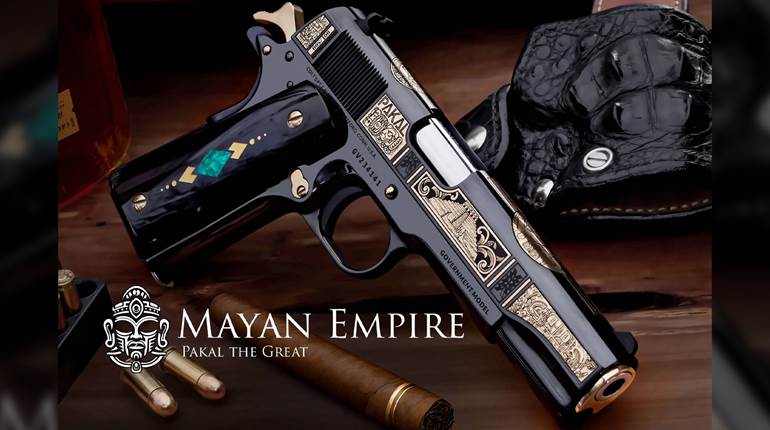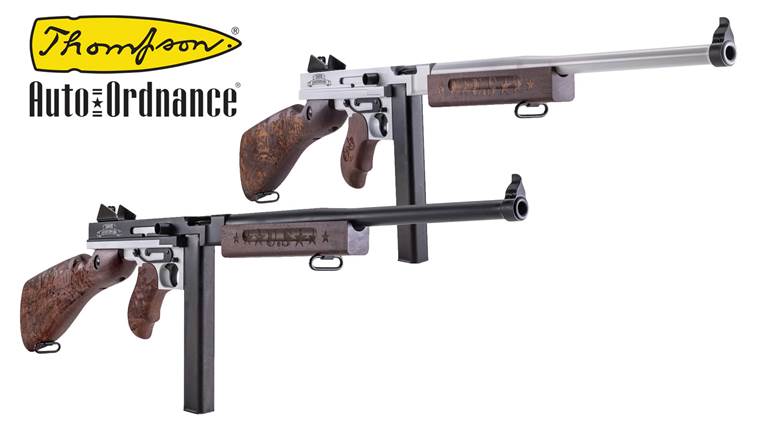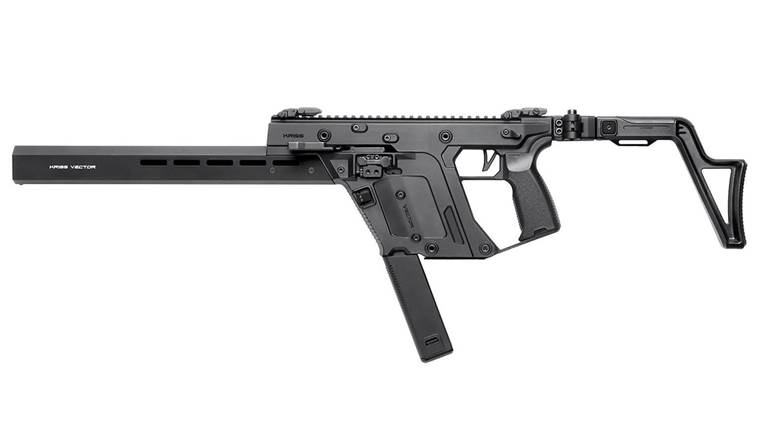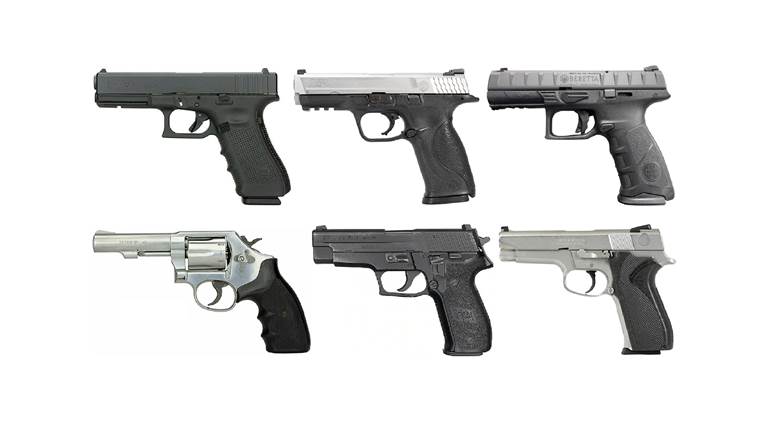
This story originally ran in American Rifleman—April 2003.
My grandmother always said I was trouble. Now here I was, surrounded by a SWAT team. Mother of mercy! Is this the end of Rico? Not quite. It’s actually the start of the story of how Kimber landed one of the most prestigious law enforcement contracts—Los Angeles Police Department’s Special Weapons and Tactics unit.
SWAT teams are old hat to us now, but there was a time not too long ago when they were a brand new concept. And that concept originated with the LAPD.
SWAT—Born of Necessity
In the aftermath of the Watts riots of the 1960s, it was quickly realized that new tools and techniques were going to be needed to combat the growing lawlessness and civil unrest in the country. Traditional law enforcement methods were found to be ineffective at dealing with large, wholesale disturbances and/or highly motivated perpetrators driven by drugs or political zeal rather than the more traditional—and easily dealt with motive—greed.
It was subsequently determined that a small, highly specialized unit comprised of some of the police force’s finest officers should be formed. Those officers would be equipped with special tools and trained in the latest crime intervention techniques, and would be on standby to respond to any incident beyond the scope of traditional law enforcement. The unit was constituted from volunteers within the department, and tactics and tools were continuously refined through testing and experience. Most of this development took place beneath the public’s radar, until the Symbionese Liberation Army (SLA) seized both newspaper headlines and newspaper heiress Patty Hearst.
SWAT responded with grim determination and dramatically battled the would-be revolutionaries. When the dust cleared, the SLA was no more and the public was suddenly aware of a potent new crime-fighting force: LAPD SWAT. The obligatory television show followed shortly thereafter. The obligatory updated theatrical film version has also been made. SWAT became—and remains—an accepted part of American law enforcement and even American popular culture. If, in the parlance of the darker side of Hip Hop, “original gangsta” is an appellation of respect, then, to the law-abiding, LAPD SWAT is the “original gangbuster.”
So esteemed is LAPD SWAT among other law enforcement agencies that the unit gets one to three calls per day from other departments around the world seeking advice on equipment. Thus, when it came time for LAPD SWAT to select its first-ever issue sidearm, it was clear that a lot of people were going to take notice of their choice.
When “Make Do” Won’t Do
Originally, SWAT officers bought their own arms. Eventually, though, as need arose and new products became available, the city began purchasing the tools of the trade—except for handguns. LAPD SWAT officers instead used M1911 pistols confiscated from criminals and refurbished in the department armory. LAPD armorers would bring the guns up to spec, but the pistols were of assorted brands with each having various features. They were all of the M1911 pattern, though, and all chambered for the .45 ACP cartridge. They worked and that was good enough—for a while.
While an officer’s sidearm—even a SWAT officer’s—is rarely fired in action on the street, SWAT’s relentless training puts an enormous number of rounds through the guns. It eventually became time to retire the well-worn and motley lot of confiscated pistols. Thus began the great pistol search.
Seek and Ye Shall Find
The search was an inclusive process that took more than a year—once funding was available—and considered input from everyone who had a stake in the matter, from the officers on up. It was generally agreed that the single-stack M1911 pistol remained the preferred sidearm for SWAT operations. It was durable and had broad shooter applicability.
Reliability is paramount in any service arm but, beyond that, LAPD SWAT would assess the new pistol for sight system, trigger pull, trigger reset, accuracy, chambering, ergonomics and felt recoil. The pistol would also have to comply with California safety regulations, which meant a firing pin blocking safety. Note, though, that price was rightly not considered. The chambering would remain unchanged; the .45 ACP was felt to offer superior stopping power. With the system and chambering determined, it remained only to find the M1911 that best satisfied LAPD’s criteria.
Representative guns were solicited from five top manufacturers and put through their paces. After being wrung out by the officers and gone over with a finetooth comb by the armorers, one gun emerged victorious—the Kimber. And not one of the company’s deluxe bells & whistles models from the Custom Shop, either, but rather its base gun, the 5-inch-barreled Kimber Custom II. LAPD SWAT asked only that tritium self-luminous night sights and 30 line-per-inch checkering on the frontstrap be added. According to sources, LAPD SWAT insisted on purchasing the Kimber product even though another manufacturer offered to provide its pistol free of charge.
To call the Custom II a “base” model is a little misleading, seeing as how Kimber several years ago elevated “standard” features into the stratosphere and forever changed the M1911 market. Prior to the arrival of the Kimber .45, a match-grade barrel, match-grade trigger, speed hammer, extended thumb safety, high-rise beavertail grip safety with raised pad, high-radiused frame, lowered and flared ejection port, and front and rear cocking serrations were all pricey custom features for an M1911 and had to be special-ordered or installed by a gunsmith. Today, most of these features are industry-standard, thanks to Kimber.
Moreover, because the gun selected by LAPD SWAT is a base model with but two embellishments, Kimber is able to offer it to the public as the Custom TLE II (Tactical Law Enforcement). The only salient difference between LAPD SWAT pistols and commercial specimens will be the serial numbers; LAPD SWAT guns have a distinct series of numbers beginning with KLA114, in recognition of the unit’s radio call sign, LA114.
“You’re Surrounded”
Fortunately for me, my being surrounded by a SWAT team was only for the purpose of watching them train with their new sidearms. Contrary to the impression one gets seeing them in action on the news, the SWAT officers are a pleasant and friendly group of individuals who just happen to know 101 ways to put you out of commission. The 80 men who make up the team are a varied group of different sizes, ages and ethnicities. What they have in common, though, is professionalism, commitment to the mission and remarkable physical fitness. Dressed in BDUs, they train and then train some more to keep their myriad skills finely honed.
Selected from LAPD’s Metro force, which is itself composed of officers who’ve worked their way up from Patrol, the SWAT officers take their mission very seriously. There is, of course, the camaraderie and jocularity common to any group of men who work closely together, but when it’s time to get down to the life and death business of their craft, the men focus with a high degree of intensity.
In addition to their new Kimber pistols, LAPD SWAT is armed with Benelli shotguns, Colt AR-15 rifles, Robar-modified Remington 700 counter-sniper rifles, Heckler & Koch submachine guns and AR-type M4 carbines. Additionally, they have all of the ancillary equipment that may be needed in an emergency: flash-bang grenades, smoke canisters, bullet-proof vests, tactical knives, rapelling gear—you name it.
The Job
As is the case with most law enforcement entities, not all LAPD SWAT officers are gun aficionados, per se. They view their guns as essential tools that provide them with response options. On the other hand, they appreciate having the best tools available to provide for their safety and the proper resolution of the crisis.
Crisis resolution is something you hear a lot about from SWAT. It’s not about discharging a firearm; it’s about resolving a bad situation with minimal harm to all involved—the perpetrator, the officer and the public. As LAPD SWAT Commanding Officer Lt. II Michael Albanese explained, it is critical that members of his unit maintain their focus on the humanity of both the victims and the perpetrators.
LAPD SWAT is divided into two smaller teams which are alternately on call. When not occupied in responding to a SWAT call-up, officers spend their time serving high-risk warrants, backing up Metro and Patrol officers, working out and, of course, training.
Kimber Goes Online
Each officer is issued two Kimber pistols, one with and one without a gun-mounted SureFire flashlight. As the lights are not quickly detachable, officers carry the light-enhanced guns when they know that they’ll be operating in a low-light environment and the plain pistols supplemented with hand-held lights for general duty. Light is now widely acknowledged as a “force level option” in law enforcement, thanks largely to the powerful units produced by SureFire and the techniques developed by the SureFire Institute.
Officers underwent a brief but thorough transition to the Kimbers, familiarizing themselves with their new handguns both in the classroom and at the range. Department armorers, as well as Kimber personnel, were on hand to explain take-down procedures and maintenance, and to see if any individual’s shooting technique necessitated front sight modification. Despite the workout the officers gave their guns, save for the needed sight tweaks for some officers, there was no grumbling about the pistols’ performance. LAPD SWAT’s sidearm is now on a par with the general excellence of its other gear and the unit as a whole.
While even the best pistol is generally a distant second to a long-arm in combat, there are several circumstances where the pistol is more suitable. These may include very close quarters where a long-gun cannot be easily swung or maneuvered, times when an officer needs one hand free to manipulate another piece of equipment or control a suspect, or as a back-up to a long-gun that has run empty.
As Lt. II Albanese likes to say of SWAT, “We’re the last phone call.” SWAT officers are the “go-to” guys in a crisis and, when the chips are down, the Kimber Custom TLE II is now their “go-to” gun.





































